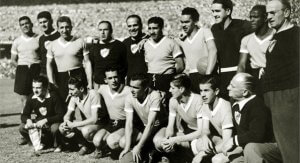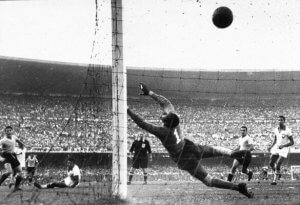Almost 70 Years After the Maracanazo in Uruguay

No matter how much time has passed, in South America, people still talk about “The Maracanazo” in the 1950 World Cup. In this article, we’ll tell you about the Uruguayan team’s feat against Brazil at the Maracanã Stadium.
World Cup Brazil 1950
The fourth World Cup was in Brazil in 1950, after the 1942 and 1946 editions were suspended by World War II. They named the competition “Jules Rimet” in honor of the French FIFA president at the time.
In this World Cup, 13 teams played. Six were from Europe, and seven from America. The return of Uruguay- which had only participated in the first World Cup in 1930 in Uruguay- and the debut of England were important additions.
This 1950 World Cup was the only one where there wasn’t a final match. This was the format: they divided teams into four groups and had to play each other once. The first place from each group went into a group where they all played each other.
There were six stadiums that held the World Cup: the Maracanã in Rio de Janeiro, the Ilha do Retiro in Recife, the Pacaembu in São Paulo, the Estádio Sete de Setembro in Belo Horizonte, the Durival de Britto in Curitiba, and the Eucaliptos in Porto Alegre.
The final phase
Those that went to the second phase were (in order of groups): Brazil, Spain, Sweden, and Uruguay. Brazil won 7-1 against Sweden, and Uruguay tied, 2-2 against Spain.

Brazil won again in the second game, 6-1 against Spain, and Uruguay won 3-2 against Sweden. In the last game, Sweden defeated Spain 3-1 in São Paulo, while in the Maracanã, you could see the faces of the Verdeamarelos and the Charrúa.
The Maracanazo of Uruguay
On July 16, 1950, they played the last two World Cup matches. However, many people believe that the match between Brazil and Uruguay was the final game. In front of 200,000 spectators, the local was the clear favorite. In addition, Brazil hadn’t lost a single game and was the top scorer of the tournament.
On the other hand, Uruguay, a team that was actually one of the best in the world, was considered the weaker team. That same morning, the confident Brazilians thought they were already champions. In fact, many newspapers- not just sports papers- put winning titles on the front page. They even started making carnival floats to celebrate their win!
People thought Brazil would win so much that the Uruguayan diplomats reportedly asked the players to suffer “a worthy defeat” for as few goals as possible.
How the Maracanazo happened
The Uruguayan coach arranged a defensive formation to prevent the landslide since the locals were sure they would win. The first surprise came after the first 45 minutes when both teams went to the locker room without scoring any goals.
That was enough for the Verdeamarelos to become champions. However, two minutes into the second half, Friaca scored the first goal, and both the stadium and the country celebrated.

Despite this, Uruguay showed that it wouldn’t give up so easily. At 21 minutes, Juan Alberto Schiaffino tied the score. Perhaps it was because the Brazilians would still be champions with this score that they became complacent.
At 34 minutes and after a great play by Obdulio Varela, Alcides Ghiggia scored the second goal for Uruguay and turned the game around. The Maracanazo of Uruguay was possible! The final minutes were agonizing because Brazil tried to tie, but unsuccessfully.
This way, Uruguay not only became the world champion– for the second time- but also won a match in their opponent’s own home. However, there were negative effects. Brazilians still think that it was the worst tragedy, the most humiliating sports defeat in history.
Lastly, one more interesting fact: the Maracanã Stadium had an unpainted entrance when the World Cup began. They decided to wait to use the color of the team that won. Therefore, the color is light blue, in honor of the Uruguayan jersey!
No matter how much time has passed, in South America, people still talk about “The Maracanazo” in the 1950 World Cup. In this article, we’ll tell you about the Uruguayan team’s feat against Brazil at the Maracanã Stadium.
World Cup Brazil 1950
The fourth World Cup was in Brazil in 1950, after the 1942 and 1946 editions were suspended by World War II. They named the competition “Jules Rimet” in honor of the French FIFA president at the time.
In this World Cup, 13 teams played. Six were from Europe, and seven from America. The return of Uruguay- which had only participated in the first World Cup in 1930 in Uruguay- and the debut of England were important additions.
This 1950 World Cup was the only one where there wasn’t a final match. This was the format: they divided teams into four groups and had to play each other once. The first place from each group went into a group where they all played each other.
There were six stadiums that held the World Cup: the Maracanã in Rio de Janeiro, the Ilha do Retiro in Recife, the Pacaembu in São Paulo, the Estádio Sete de Setembro in Belo Horizonte, the Durival de Britto in Curitiba, and the Eucaliptos in Porto Alegre.
The final phase
Those that went to the second phase were (in order of groups): Brazil, Spain, Sweden, and Uruguay. Brazil won 7-1 against Sweden, and Uruguay tied, 2-2 against Spain.

Brazil won again in the second game, 6-1 against Spain, and Uruguay won 3-2 against Sweden. In the last game, Sweden defeated Spain 3-1 in São Paulo, while in the Maracanã, you could see the faces of the Verdeamarelos and the Charrúa.
The Maracanazo of Uruguay
On July 16, 1950, they played the last two World Cup matches. However, many people believe that the match between Brazil and Uruguay was the final game. In front of 200,000 spectators, the local was the clear favorite. In addition, Brazil hadn’t lost a single game and was the top scorer of the tournament.
On the other hand, Uruguay, a team that was actually one of the best in the world, was considered the weaker team. That same morning, the confident Brazilians thought they were already champions. In fact, many newspapers- not just sports papers- put winning titles on the front page. They even started making carnival floats to celebrate their win!
People thought Brazil would win so much that the Uruguayan diplomats reportedly asked the players to suffer “a worthy defeat” for as few goals as possible.
How the Maracanazo happened
The Uruguayan coach arranged a defensive formation to prevent the landslide since the locals were sure they would win. The first surprise came after the first 45 minutes when both teams went to the locker room without scoring any goals.
That was enough for the Verdeamarelos to become champions. However, two minutes into the second half, Friaca scored the first goal, and both the stadium and the country celebrated.

Despite this, Uruguay showed that it wouldn’t give up so easily. At 21 minutes, Juan Alberto Schiaffino tied the score. Perhaps it was because the Brazilians would still be champions with this score that they became complacent.
At 34 minutes and after a great play by Obdulio Varela, Alcides Ghiggia scored the second goal for Uruguay and turned the game around. The Maracanazo of Uruguay was possible! The final minutes were agonizing because Brazil tried to tie, but unsuccessfully.
This way, Uruguay not only became the world champion– for the second time- but also won a match in their opponent’s own home. However, there were negative effects. Brazilians still think that it was the worst tragedy, the most humiliating sports defeat in history.
Lastly, one more interesting fact: the Maracanã Stadium had an unpainted entrance when the World Cup began. They decided to wait to use the color of the team that won. Therefore, the color is light blue, in honor of the Uruguayan jersey!
All cited sources were thoroughly reviewed by our team to ensure their quality, reliability, currency, and validity. The bibliography of this article was considered reliable and of academic or scientific accuracy.
- Mediotiempo. El Maracanazo, la derrota histórica que marcó a los brasileños y ocasionó suicidios. Julio 2019. https://www.mediotiempo.com/futbol/el-maracanazo-que-es-por-que-se-llama-asi-datos-curiosos
- A 68 años del “Maracanazo”. Sitio oficial Club Atlético Peñarol. https://www.xn--pearol-xwa.org/Noticias/A-68-anos-del-Maracanazo–uc2959
- Taveira, F. 2018. Suicidios en masa y un arquero condenado por “la mala suerte”: el otro lado del Maracanazo. Infobae. https://www.infobae.com/america/deportes/mundial-rusia-2018/2018/02/24/suicidios-en-masa-y-un-arquero-condenado-por-la-mala-suerte-el-otro-lado-del-maracanazo/
This text is provided for informational purposes only and does not replace consultation with a professional. If in doubt, consult your specialist.








